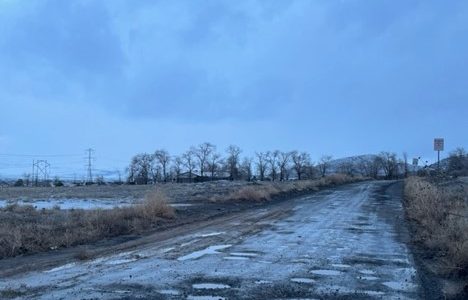An action item that came before the Eagle Mountain City Planning Commission this week is generating a response from affected residents.
The proposal amends the Lower Hidden Valley Master Development Plan in preparation for the construction of new residential dwelling units near Hidden Hollow Elementary School. The land developer hopes to begin construction as early as May or June of this year.
Several residents have communicated their concerns regarding what this development means for some of the community’s hiking and mountain biking trails, as well as the City’s wildlife migration corridor.
The proposal under consideration
Before construction can begin, the land developer, Perry Homes, has indicated an interest in adjusting the location and the density of some of the housing within the development proposal.
While the project originally included a proposal for a variety of multi-family units, the amendment that was under consideration at this week’s Planning Commission meeting proposes the prioritization of single-family homes over multi-family complexes.
The amendment also makes some accommodations, at the City’s request, to generally maintain the City’s wildlife migration corridor.
Eagle Mountain City accommodated development plans years ago
In 2011, Eagle Mountain City and OMR Investments completed signing a Master Development Agreement (MDA) that allowed Perry Homes to construct 1,256 residential dwellings, including a mix of housing types and densities, in the Lower Hidden Valley area.
Vested rights
Developers were granted “vested rights,” which allow the land to be developed anytime the developer decides to move forward with a development project, despite future changes to City ordinances.
According to Cornell University Law School, a vested right is “an absolute right or title to something, to be enjoyed either now or in the future.”
Eagle Mountain City Community Development Director Steve Mumford says the 2011 Master Development Agreement solidified building in the area.
“[The MDA] gave [developers] the right to develop their property with what was approved including the road locations, the types of development, the type and number of units and the open space areas where they’re shown,” says Mumford.
The impact on hiking and mountain biking trails
While the land has remained undeveloped, several trails have been constructed on the property intended for development that have become very popular among residents and visitors for hiking, trail running and mountain biking.
One resident shared data at this week’s Planning Commission meeting suggesting that, according to the Trailforks App, Eagle Mountain has four mountain bike trails in the top 1,000 trails in the world, and that the Deadwood trail, located further up the hill, is ranked as #567 globally.
Because many of these trails were built on private property, most of the trails will need to be relocated or removed when the property owner uses their property rights to develop.
Portions of the trails, however, have been constructed on undevelopable land and will likely not be affected because of the slope of the hill and Eagle Mountain’s ridgeline protection ordinance.
Mumford says that whether the new proposal is approved, or the existing “vested” project is constructed, the City and the mountain biking community are working to find suitable locations to relocate and preserve many of the trails so they remain accessible to residents and visitors.
“I consider myself part of the mountain bike community,” says Mumford. “I’ve ridden these trails many times and would hate to see them disappear. I also understand that the property owner has rights and that the trails were created without his permission. I’m hopeful that we can work together with the land developer to relocate and preserve as many of these trails as possible while still allowing development of his land.”
The impact on wildlife
When the Master Development Agreement was approved in 2011, there were not yet plans to preserve space for the wildlife migration corridor.
The proposed amendment to the MDA would make some accommodations for the wildlife corridor by providing fencing and a wildlife passage area within the development.
The Eagle Mountain Nature and Wildlife Alliance presented an alternative plan for the wildlife corridor at the Planning Commission meeting, which included preserving a 38.5-acre City-owned parcel for a bike park and the wildlife.
Todd Black, Eagle Mountain City Wildlife Biologist, has been working with the Eagle Mountain Wildlife Alliance and appreciates the developer’s willingness to work with the City to preserve the corridor. He looks forward to adding wildlife fencing and making improvements for the wildlife as soon as possible.
“I think this plan is a win for the wildlife,” says Black.
City staff have been working closely with the developer and wildlife experts to maintain the safest passage possible for wildlife to travel through the area intended for development.
Robert Hobbs, Planning Manager with Eagle Mountain City, says talks have been productive with the developer.
“The City has been trying to lobby the developer to provide the wildlife corridor some fencing and make sure we have correct access points on Pony Express [Parkway] and a way for deer to cross,” says Hobbs.
City-owned parcel up for debate
Eagle Mountain City owns a 38-acre parcel situated near the proposed development. The parcel was acquired by the City years ago through the payment of back property taxes (Special Improvement District taxes).
What will be done with the land will be under consideration by the City Council in the near future. They will decide whether to preserve the parcel for open space and recreation, or to sell or trade a portion of the parcel to the developer. This would increase the number of single-family homes and reduce the multi-family buildings.
If the 38-acre parcel is developed, only a portion would be built-out due to the slopes of the geography and its potential conflict with the City’s hillside development standards.
While they indicated an appreciation of the efforts made to protect the wildlife corridor and the reduction of multi-family units, the Eagle Mountain Planning Commission ultimately recommended denial (4-0) of the developer’s proposed amendments to the project on Tuesday night.
The proposal is anticipated to be reviewed by the City Council in February.











